Abstract
Ultrasonic vocalizations (USVs) are essential communicative sounds used between rodent pups and their mother. Rat pups emit USVs in stressful situations, such as when they are cold or separated from the nest. We verified the ontogenetic changes in USVs emitted by infant rats isolated from their mother during the pre-weaning period. The number of calls, and the median frequency and first peak of frequency of the calls were measured at 1, 3, 5, 7, 10, 12, and 14 days postnatal age in Wistar-Imamichi rats. Pups were placed in a cold glass beaker and USVs were recorded for 5 min. The number of calls increased to a peak on day 5 and then gradually decreased. The median frequency of calls decreased slowly during the first 12 days, and then increased slightly on day 14. Similarly, the first peak frequency of calls was the highest on day 1, and then decreased gradually by day 12. A small increase was observed on day 14. These changes in frequency were correlated with the physical development of the pups, whose body weights increased significantly with age except during postnatal days 7-10.
Premature rodent pups are born underdeveloped; they are deaf, blind, hairless, short of subcutaneous fat, and have limited motor function. At this early stage, pups cannot regulate their body temperature [1], so when they are removed from their mother and littermates their body temperature decreases rapidly, and their chances of survival decrease at this crucial stage if they are not returned immediately to the nest. Thus, in their first stage of life, pups' survival is highly dependent on maternal care. Pups need their mother to provide food and warmth, and to keep them clean. Pups emit ultrasonic vocalization (USVs) to communicate with their mother when they are separated from the nest, their mother, or littermates, and when they are cold, exposed to a novel environment, hungry, or handled by humans [2-7]. For this reason, rat pup USVs have been called an isolation or distress call that serves as social communication.
A few studies have shown that USVs are produced as an acoustic by-product of the physiological changes that maintain cardiopulmonary homeostasis [8,9], for example, the reflexive abdominal compression in response to cold, which results in an increase in the venous return of blood to the heart and increased respiration rate and oxygen consumption. These changes increase breathing rate and result in increased air flow through the trachea and larynx. Considerable pressure is generated in the trachea and pulmonary system below the larynx, and sound is produced as a result of laryngeal constriction against the exhaled air, which is referred to as "laryngeal barking." In addition, USVs are emitted in the nest at the beginning and end of each bout of nursing [4]. When mothers hear USVs, they immediately search for the source of the sound, build a nest, and bring the pups to the nest [10,11]. The pups' USVs appear to induce and maintain maternal behavior.
Previous reports have shown that isolation-related calling in Sprague-Dawley rats pups is age-specific. USVs in response to maternal isolation are not observed until postnatal day (PND) 7 and then decrease from PND 13 until PND 23, at which point USVs are absent [12]. Similarly, lactating rats show maternal behavior within 30 min after parturition, which increases for 10 days postpartum and then decreases around 2 weeks postpartum when the pups are able to consume solid food. Pups develop the ability to survive without their mother's care. The present study investigated the age-specific USVs with the number and the first peak and median frequencies of pre-weaned rats as a response to hypothermic conditions. The USVs of male and female pre-weaning Wistar-Imamichi rat pups were induced under hypothermic conditions and analyzed qualitatively and quantitatively.
Wistar-Imamichi rat pups were bred and used in our laboratory. Six-week-old male and female rats were obtained from Imamichi Institute for Animal Reproduction (Tsuchiura, Ibaraki, Japan). Male rats were housed individually, and female rats were housed in groups of four per polycarbonate cage (220×380×200 mm) with wood-chip bedding. The animal room was maintained at 22-27℃ with 12 h artificial lighting from 07:00 to 19:00. All animals were allowed free access to a solid diet (Lab MR Stock, Nihon Nosan, Inc., Yokohama, Japan) and tap water.
Vaginal smears were taken daily from females that had been acclimated to the environment for 2 weeks. Rats that had at least two consecutive 4-day estrous cycles were used. On the evening of proestrous, female rats were caged overnight with male rats and were inspected for the presence of a vaginal plug and sperm in vaginal smears the following morning (day 0 of pregnancy). Pregnant rats were housed in groups until day 18 of pregnancy and then individually transferred to polycarbonate cages with wood-chip bedding for delivery.
A total of 72 pups, 36 males and 36 females, were used for observing physical development and measuring isolation calls at 1, 3, 5, 7, 10, and 14 days postnatal age. Twelve pups, six males and six females, were selected randomly from each postnatal age group, and each pup was identified to prevent using it repeatedly in the experiment.
The animal studies were approved by the Institutional Animal Care and Use Committee of the Nippon Veterinary and Life Science University and carried out in accordance with the National Institutes of Health, USA Guide for the Care and Use of Laboratory Animals. All efforts were undertaken according to the "3R principles" of the directive to reduce the number of animals used in this study, and optimize experimental protocols for obtaining maximum data from each tested animals.
Each pup was photographed to observe physical development and then weighed in the morning of the experimental day. As shown in Figure 1, USVs were recorded from 13:00 to 15:00. A pup was placed in a 500 ml glass beaker in isolation. Then the glass beaker was put in an incubator on an ice bag (approximately 10℃) to attenuate surrounding sounds for 5 min. A condenser microphone (SF-12DC, Kunitachi Acoustic Lab., Kunitachi, Japan) was located above the pup. The microphone was connected through a microphone amplifier (DIA Medical Systems, Kunitachi, Japan) to a computer installed with Real-Time Spectrogram software (RTS, Engineering Design, Tokyo, Japan). The frequency response of the microphone was ±0.5 dB in a frequency range of 5-100 kHz.
USV spectrograms (Figure 2A) were run in post-process mode using SpectraLab software (SpectraLab V.4.32, Sound Technology Inc., Tokyo, Japan). The total number of calls was counted for a 5-min interval, and the peak frequency of each USV was measured. The mean and median of the peak frequencies were calculated. The total number of calls was considered the number of USVs emitted in 5 min. The strongest frequency component of each call was measured and recorded as the peak frequency, which was plotted, and the lowest peak frequency was identified as the first peak frequency. The area under the curve of the peak frequency was calculated. The frequency at the point of half the area under the curve was identified as the median frequency (Figure 2B).
The results are expressed as means±SE and were analyzed using one-way ANOVA for repeated measures with the aid of the GB-Sat statistical program for Macintosh computers (Dynamic Microsystems, Silver Spring, MD, USA). When a significant effect was detected by ANOVA, the significance of difference between means was determined by Tukey's test. A value of P<0.05 was considered significant.
Rat pup body weights increased gradually with age until PND 10 and then increased sharply on PND 12. By PND 14, the body weights had increased slightly. Body weight was significantly different among all ages except for PND 7-10. No significant body weight differences were observed between the genders. Body weights of male pups tended to be higher than those of female pups except for those on PND 10 and 12 (Figure 3).
The number of calls showed a slight increase on PND 12 (455±96 times), and then decreased on PND 14 (67±15 times). No significant difference was observed between the genders except on PND 10 when the male pups called more than female pups (443±114 and 198±79 times, respectively). Calls on PND 1 and 3 were initially clustered together. By PND 5, calls were less clustered and began to be separated into discrete individual vocalizations. By PND 7, calls were separated and no longer clustered (Figure 4A).
The number of calls was counted in 5 min. The number of calls sharply increased from birth to PND 5 (578±39 times), and then decreased until PND 10 (320±76 times) (Figure 4B).
The first peak frequency of calls decreased from 50.25±0.45 kHz on PND 1 to approximately 34.38±0.65 kHz on PND 12, and then slightly increased to 38.75±1.09 kHz on PND 14. No significant difference was observed between the genders (Figure 5).
The median frequency of calls slowly decreased from 50.56±0.31 kHz on PND 1 to 41.63±0.68 kHz on PND 7 and was unchanged until PND 10. On PND 12, the median frequency of calls decreased to 36.68±0.53 kHz, and finally increased to 40.13±0.75 kHz on PND 14. No significant differences were observed between male and female pups (Figure 6).
The USVs of the rat pups changed distinctly during the first 2 weeks after birth. The changes in USVs were correlated with the morphological development of the pups. During the first 2 weeks, the pups grew and developed rapidly, that is, they grew fur, their eyes opened, and their motor functions improved. As the pups grew, the frequency of USVs decreased. The first peak frequency decreased from 50.25±0.43 kHz on PND 1 to 38.75±1.09 kHz on PND 14. Similarly, the median frequency decreased from 50.59±0.31 kHz on PND1 to 40.13±0.75 kHz on PND 14. Calls were clustered together until PND 3, but began to be separated into individual calls on PND 5. After PND 7, USVs were no longer clustered but were separated into individual calls. Only a few USVs were emitted by the pups by PND 14.
As the pups grew, the frequency of USVs decreased. This may have been due to the growing trachea and muscles of the larynx. Air flow through a larger trachea and larynx will have a lower frequency, and the capacity and control of the muscles in the larynx changes as the nervous system develops and control via the inferior (recurrent) and superior laryngeal branches of the vagus nerve improves.
On PNDs 1 and 3, the rat pups responded to a cold environment by emitting USVs in the same manner. After PND 5, the USVs changed, suggesting that the USVs emitted in the first 3 days might be a reflex response of the autonomic nervous system. Rathner et al. [13] reported that the brain stem alone is sufficient to produce USVs in rat pups <7 days of age. The periaqueductal gray (PAG) matter is important for generating USVs in the first week after birth [14]. The ear canals open at approximately 1 week of age, and the eyes open at about 2 weeks of age. After the ear canals open, the pups emitted individual USVs with a peak frequency that decreased with age to a minimum on PND 12. After PND 12, the frequency increased to an "adult-like USV" on PND 14. A clear difference in USVs was detected after the ear canal opened and the auditory system started to function. After hearing and perceiving the sound, USVs may no longer be a reflex response but rather may be processed in the brain before being emitted. These observations are consistent with those of Hofer et al. [12], who showed that rat pups isolated from their mother only emit USVs after PND 7, and this may reflect the time at which they become more aware of their surroundings.
We found that the USVs of rat pups in response to a hypothermic stimulus changed as the pups matured. As their body weights increased and the rats developed with growing their hair, the number of calls and their first peak and median frequency decreased. The USVs emitted during the first week after birth may be an autonomic response. As the rats' nervous systems develop and their ear canals and eyes open, the USVs may become a conscious response that is processed by the brain.
Acknowledgments
The authors would like to express our gratitude to Professor Dr. Gyorge M. Nagy, Neuroendocrine Research Laboratory, Department of Human Morphology, Hungarian Academic of Science and Semmelwies University, Budapest, Hungary for his valuable advice. This study was supported in part by grants-in-aid for Scientific Research from the Society for Encouragement of Biomedical Education, Heiwa Nakajima Foundation and Rotary Yoneyama Memorial Foundation to PK.
References
1. Alberts JR. Huddling by rat pups: group behavioral mechanisms of temperature regulation and energy conservation. J Comp Physiol Psychol. 1978; 92(2):231–245. PMID: 670452.

2. Allin JT, Banks EM. Effects of temperature on ultrasound production by infant albino rats. Dev Psychobiol. 1971; 4(2):149–156. PMID: 5162545.

3. Blumberg MS, Efimova IV, Alberts JR. Ultrasonic vocalizations by rat pups: the primary importance of ambient temperature and the thermal significance of contact comfort. Dev Psychobiol. 1992; 25(4):229–250. PMID: 1624055.

4. Hofer MA, Shair H. Ultrasonic vocalization during social interaction and isolation in 2-week-old rats. Dev Psychobiol. 1978; 11(5):495–504. PMID: 689298.

5. Hofer MA, Shair H. Sensory processes in the control of isolation-induced ultrasonic vocalization by 2-week-old rats. J Comp Physiol Psychol. 1980; 94(2):271–279. PMID: 7364999.

6. Hofer MA, Shair HN. Isolation distress in two-week-old rats: influence of home cage, social companions, and prior experience with littermates. Dev Psychobiol. 1987; 20(4):465–476. PMID: 3609493.

7. Oswalt GL, Meier GW. Olfactory, thermal, and tactual influences on infantile ultrasonic vocalization in rats. Dev Psychobiol. 1975; 8(2):129–135. PMID: 1225689.

8. Blumberg MS, Alberts JR. Ultrasonic vocalizations by rat pups in the cold: an acoustic by-product of laryngeal braking? Behav Neurosci. 1990; 104(5):808–817. PMID: 2244987.

9. Blumberg MS, Sokoloff G. Dynamics of brown fat thermogenesis in week-old rats: evidence of relative stability during moderate cold exposure. Physiol Zool. 1997; 70(3):324–330. PMID: 9231406.

10. Ehret G, Haack B. Categorical perception of mouse pup ultrasound by lactating females. Naturwissenschaften. 1981; 68(4):208–209. PMID: 7278997.

11. Noirot E. Ultra-sounds in young rodents. I. Changes with age in albino mice. Anim Behav. 1966; 14(4):459–462. PMID: 5972804.

12. Hofer MA, Masmela JR, Brunelli SA, Shair HN. The ontogeny of maternal potentiation of the infant rats' isolation call. Dev Psychobiol. 1998; 33(3):189–201. PMID: 9810471.

13. Rathner JA, Owens NC, McAllen RM. Cold-activated raphéspinal neurons in rats. J Physiol. 2001; 535(Pt 3):841–854. PMID: 11559779.

Figure 2
USV spectrograms of rat pups and method for analyzing USV. A: USV spectrogram in rats aged 3 days. B: Methods for analyzing USV and the identification of first peak frequency and median frequency.
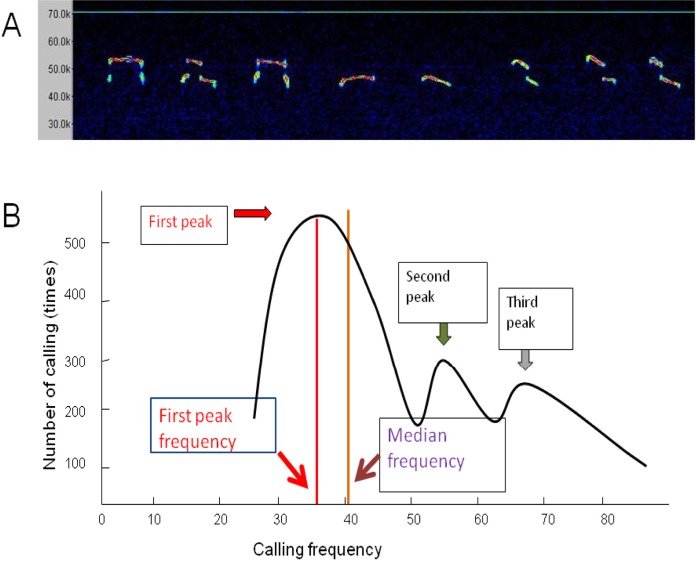
Figure 3
Body weights of rat pup postnatal days 1, 3, 5, 7, 10, 12 and 14. Data are represented as means±SEM. *P<0.05.
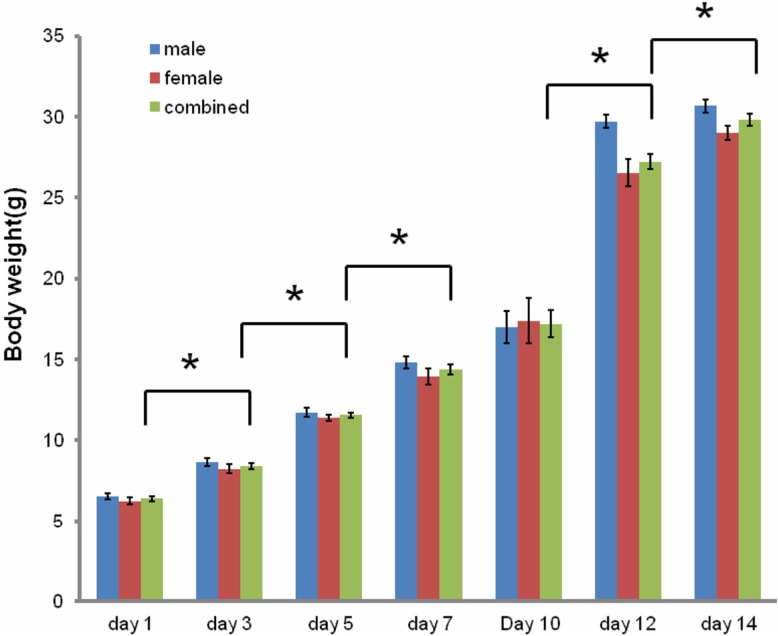
Figure 4
Number of USV of rat pups postnatal days 1, 3, 5, 7, 10, 12 and 14. A: Mean number of USV calling of each sex and number of USV in each rat pups, B: Mean±SEM of number of USV in combined sex.
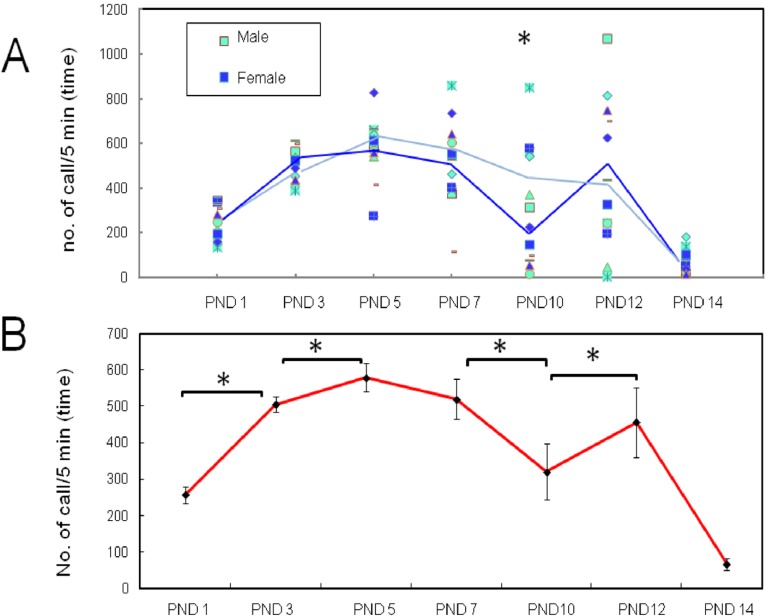




 PDF
PDF ePub
ePub Citation
Citation Print
Print


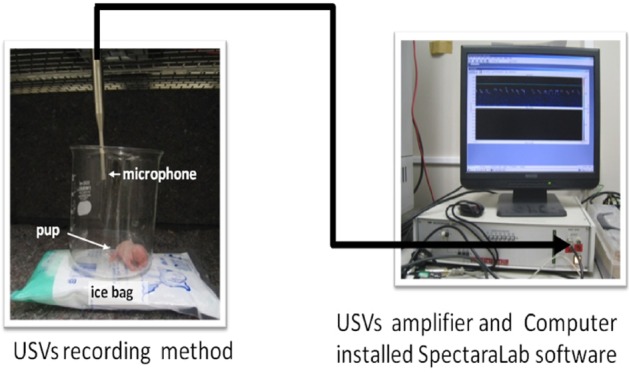
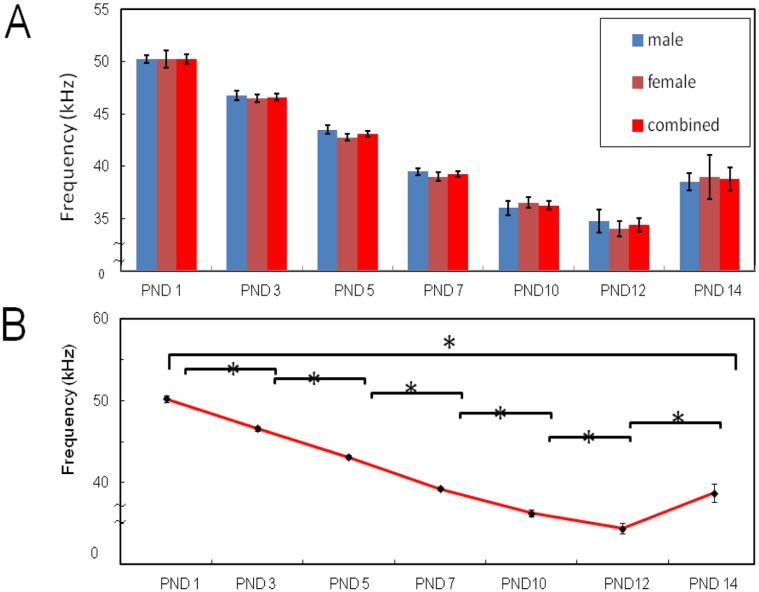
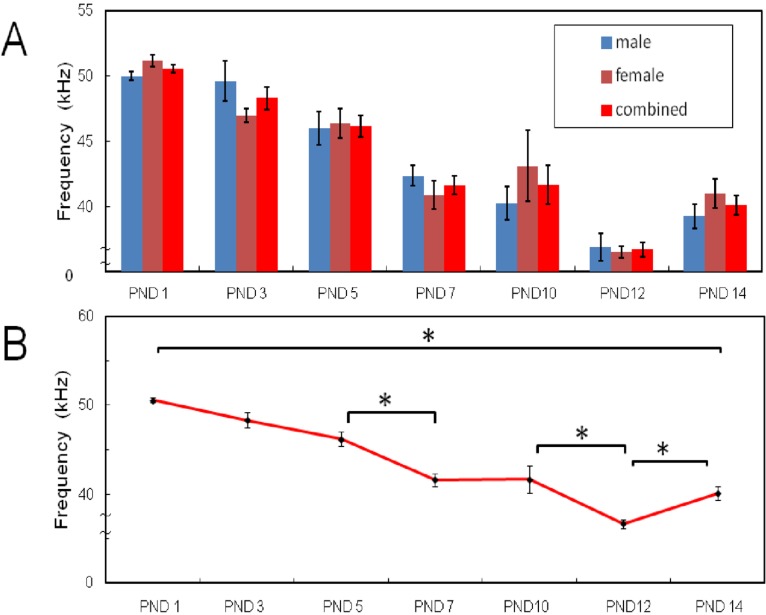
 XML Download
XML Download